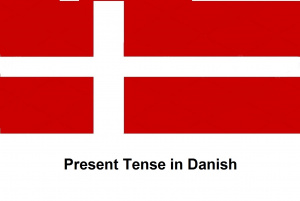Difference between revisions of "Language/Danish/Grammar/Present-Tense"
Jump to navigation
Jump to search
(The Present Tense in Danish) |
|||
| Line 1: | Line 1: | ||
[[File:The Present Tense in Danish.jpg|alt=The Present Tense in Danish|thumb|The Present Tense in Danish]] | |||
. | |||
. | |||
Hello everybody, | |||
In today's lesson you will learn '''"THE PRESENT TENSE"''' in Danish. | |||
Feel free to edit this page by adding new words and expressions ! | |||
Good learning! :) | |||
. | |||
. | |||
. | |||
In Danish, the verbs conjugate depending on the tense that you are using, not the pronoun. | In Danish, the verbs conjugate depending on the tense that you are using, not the pronoun. | ||
| Line 5: | Line 24: | ||
To form the present tense, you have to add -r to the verb, and replace the "at" with the correct pronoun depending on your subject. | To form the present tense, you have to add -r to the verb, and replace the "at" with the correct pronoun depending on your subject. | ||
The Pronouns are: | The Pronouns are : | ||
. | |||
{| class="wikitable" | {| class="wikitable" | ||
! | !'''<big><u>ENGLISH</u></big>''' | ||
! | !'''<big><u>DANISH</u></big>''' | ||
!'''<big><u>BRAZILIAN PORTUGUESE</u></big>''' | |||
|- | |||
| | | | ||
| | |||
| | |||
|- | |||
|I | |||
|'''JEG''' | |||
|EU | |||
|- | |- | ||
|YOU | |||
| | |'''DU''' | ||
|VOCÊ | |||
|- | |- | ||
|HE | |||
| | |'''HAN''' | ||
|ELE | |||
|- | |- | ||
|SHE | |||
| | |'''HUN''' | ||
|ELA | |||
|- | |- | ||
|WE | |||
| | |'''VI''' | ||
|NÓS | |||
|- | |- | ||
|YOU (PLURAL) | |||
| | |'''I''' | ||
|VOCÊS | |||
|- | |- | ||
|THEY | |||
| | |'''DE''' | ||
|ELES | |||
|} | |} | ||
Using the example of "at gå" (to go): | . | ||
Using the example of "at gå" (to go) : | |||
. | |||
{| class="wikitable" | {| class="wikitable" | ||
! | !'''<big><u>ENGLISH</u></big>''' | ||
! | !'''<big><u>DANISH</u></big>''' | ||
!'''<big><u>BRAZILIAN PORTUGUESE</u></big>''' | |||
|- | |||
| | | | ||
| | |||
| | |||
|- | |||
|I GO | |||
|'''JEG GÅR''' | |||
|EU VOU | |||
|- | |- | ||
|YOU GO | |||
| | |'''DU GÅR''' | ||
|VOCÊ VAI | |||
|- | |- | ||
|HE GOES | |||
| | |'''HAN GÅR''' | ||
|ELE VAI | |||
|- | |- | ||
|SHE GOES | |||
| | |'''HUN GÅR''' | ||
|ELA VAI | |||
|- | |- | ||
|WE GO | |||
| | |'''VI GÅR''' | ||
|NÓS VAMOS | |||
|- | |- | ||
|YOU (PLURAL) GO | |||
| | |'''I GÅR''' | ||
|VOCÊS VÃO | |||
|- | |- | ||
|THEY GO | |||
| | |'''DE GÅR''' | ||
|ELES VÃO | |||
|} | |} | ||
Revision as of 08:16, 4 July 2019
.
.
Hello everybody,
In today's lesson you will learn "THE PRESENT TENSE" in Danish.
Feel free to edit this page by adding new words and expressions !
Good learning! :)
.
.
.
In Danish, the verbs conjugate depending on the tense that you are using, not the pronoun.
The infinitive verbs always end in -e, and are always preceded by the phrase "at". For example: "at gå", meaning "to go" or "to walk".
To form the present tense, you have to add -r to the verb, and replace the "at" with the correct pronoun depending on your subject.
The Pronouns are :
.
| ENGLISH | DANISH | BRAZILIAN PORTUGUESE |
|---|---|---|
| I | JEG | EU |
| YOU | DU | VOCÊ |
| HE | HAN | ELE |
| SHE | HUN | ELA |
| WE | VI | NÓS |
| YOU (PLURAL) | I | VOCÊS |
| THEY | DE | ELES |
.
Using the example of "at gå" (to go) :
.
| ENGLISH | DANISH | BRAZILIAN PORTUGUESE |
|---|---|---|
| I GO | JEG GÅR | EU VOU |
| YOU GO | DU GÅR | VOCÊ VAI |
| HE GOES | HAN GÅR | ELE VAI |
| SHE GOES | HUN GÅR | ELA VAI |
| WE GO | VI GÅR | NÓS VAMOS |
| YOU (PLURAL) GO | I GÅR | VOCÊS VÃO |
| THEY GO | DE GÅR | ELES VÃO |
